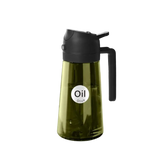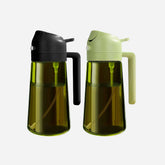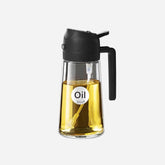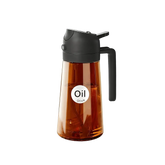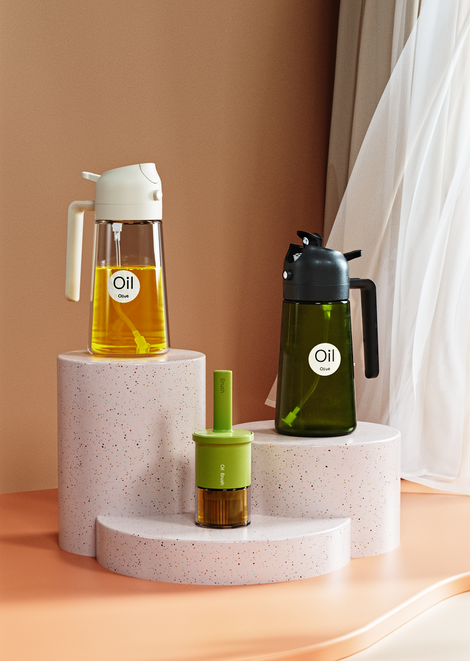Is Your Food Too Oily? Here’s How an Oil Sprayer Bottle Fixes That

1. Why Most Home Cooks Use More Oil Than They Think
Let’s be honest: when you're standing over a hot pan, a drizzle of oil can turn into a pour faster than you realize. Most of us aren’t measuring every tablespoon, and we rely heavily on visual cues—like coating the pan or covering vegetables—without realizing how much oil we’re actually using. And it adds up.
Think about it. A quick swirl of oil for sautéing, a glug for roasting, a splash for salad dressing—it’s easy to go overboard. In fact, studies show that the average home cook uses 30% to 50% more oil than they think. And while olive oil has its health perks, too much of a good thing can still pack in unnecessary calories and fat.
That’s where an oil sprayer bottle comes into play. It gives you more control and helps you spray a fine, even mist, rather than dumping a puddle. Whether you’re prepping a tray of veggies or heating up a non-stick pan, having an easy-to-use kitchen oil dispenser means you can coat your ingredients without overdoing it.
By using a sprayer, you can enjoy the flavor and texture that oil brings—crisp edges, golden browning—without drowning your meals. It’s a small change, but one that can have a big impact on your daily cooking routine (and waistline).
2. The Hidden Health Costs of Excess Cooking Oil
Extra oil doesn’t just affect your waistline—it can quietly undermine your health in ways that don’t show up until later. High oil consumption is linked to increased risks of heart disease, inflammation, and even digestive issues. It’s not that oil is bad—it’s about how much and how often you’re using it.
Many cooking oils are calorie-dense, clocking in at around 120 calories per tablespoon. That means even a few extra splashes can add hundreds of hidden calories to your meal. Over time, that contributes to weight gain, cholesterol issues, and other chronic conditions—even if you’re using so-called “healthy” oils.
It gets trickier when you're cooking foods that naturally absorb more oil—like eggplant, potatoes, or breaded items. They act like sponges, soaking up oil from the pan. That’s where using a glass olive oil dispenser with a built-in sprayer really changes the game. Instead of soaking, you're misting. Instead of coating the bottom of the pan, you're lightly dressing the top of your ingredients.
The result? You get the texture and flavor you love, but with less oil. And less oil means fewer calories, less grease, and better overall health—without sacrificing taste. It’s not about cutting corners; it’s about cooking smarter.
3. Meet the Oil Sprayer Bottle: A Small Tool with Big Impact
At first glance, an oil sprayer might not seem like a big deal. It’s small, simple, and doesn’t make noise or have a bunch of buttons. But in the kitchen, it’s a game-changer.
A well-made sprayer gives you complete control. You press once, and it delivers a light, even mist across your pan or food. No waste, no splatter, no greasy fingers. Some models even offer measurement markings or adjustable spray strength. For folks who are trying to eat lighter or just cook more mindfully, it’s a no-brainer.
The best part? It’s refillable. You can use your favorite oils—olive, avocado, sesame—and skip the aerosol cans filled with propellants and mystery ingredients. A reusable kitchen oil dispenser made of glass is not only better for your health but also better for the planet.
Plus, it’s surprisingly versatile. Use it on salads, baked potatoes, fish, toast, or even popcorn. A quick spritz is often all you need. If you’re air frying? It’s practically essential (more on that next).
Once you start using an oil sprayer, you’ll wonder how you ever managed without it. It’s one of those “why didn’t I get this sooner?” kind of tools.
4. How to Use an Oil Sprayer for Better Results in Every Dish
So how do you actually use an oil sprayer to get the best results?
First, make sure you’re using the right type of oil—something with a moderate smoke point like olive or avocado oil. Fill your bottle no more than two-thirds full (this helps build enough air pressure inside for a fine mist). Then pump or twist to build pressure, depending on the design.
When roasting vegetables, hold the bottle about 6 to 8 inches above the tray and spritz evenly. You’ll get golden, crispy results with less oil soaking into the food. When cooking meat or tofu in a pan, a light spray creates just enough of a non-stick barrier without drowning the ingredients.
And if you’re an air fryer fan? This tool is a must. The hot, circulating air of an air fryer works best with lightly oiled surfaces. A heavy hand with oil can cause uneven cooking, smoke, or soggy results. A few spritzes from an oil sprayer for air fryer makes all the difference—it helps brown the food, keeps it from drying out, and enhances crispiness without excess grease.
Even for non-cooking uses, like greasing baking pans or adding shine to bread crusts before baking, a sprayer is cleaner, easier, and more efficient than a brush or your fingers.
5. From Crispy Veggies to Juicy Chicken: Recipes That Work Better with Less Oil
Here’s where things get delicious. Once you get the hang of using an oil sprayer, the possibilities in your kitchen open up. Some recipes not only survive with less oil—they actually turn out better.
Take roasted Brussels sprouts, for example. Instead of tossing them in a bowl of oil, lay them flat on a baking sheet and spray lightly. They come out crispy on the edges and tender in the middle—without feeling greasy. The same goes for zucchini fries, sweet potato wedges, or roasted chickpeas.
Air-fried chicken thighs? Spray both sides before cooking and you’ll get that golden crust with a juicy center—no flour dredging required. Or try spritzing portobello mushrooms before grilling for a smoky, meaty bite with half the fat.
Even brunch gets better. A light spray over avocado toast gives it a finishing touch. Need a healthy side? Spray corn on the cob with olive oil and dust with chili powder before grilling.
When you use a glass olive oil dispenser, it’s not just about cutting calories—it’s about boosting flavor with better technique. You’re not sacrificing anything—you’re gaining precision.





